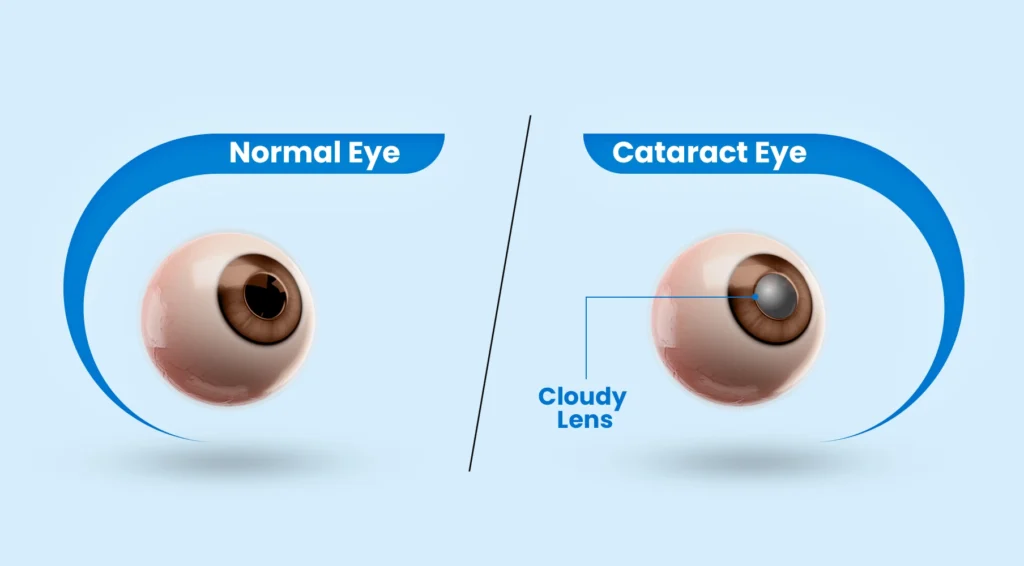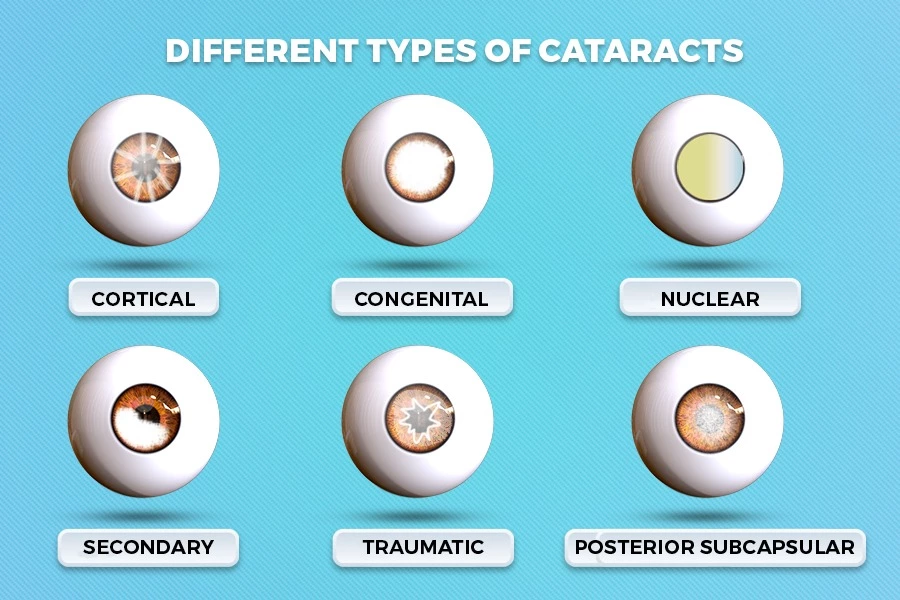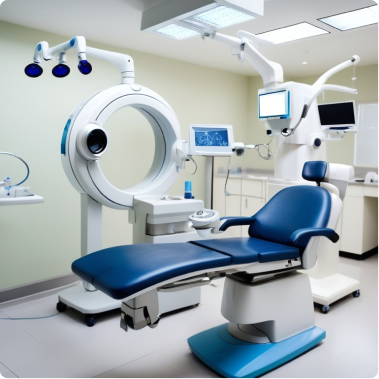What is a Cataract?
Cataract occurs when the eye’s lens gets cloudy from protein buildup, making it hard to see clearly. The lens, composed of water and proteins, normally focuses light onto the retina to produce clear images. When these proteins stick together, they form a cloudy area that blocks light, causing vision problems. Cataracts, often found in older adults, can greatly affect daily life and well-being if not treated. Understanding this condition is crucial for those considering cataract treatment in Mumbai to seek the right care and improve vision.


Types of Cataracts
- Cortical Cataracts
- Congenital Cataracts
- Nuclear Cataracts
- Secondary Cataracts
- Traumatic Cataracts
- Posterior Subcapsular Cataracts
Cortical Cataracts
Cortical cataracts start at the edges of the lens and move towards the center. They are characterized by white, wedge-like opacities that create problems with glare and depth perception. People with cortical cataracts often have trouble driving at night due to the increased glare from headlights.
Congenital Cataracts
Nuclear Cataracts
Secondary Cataracts
Traumatic Cataracts
Posterior Subcapsular Cataracts
Posterior subcapsular cataracts can progress rapidly, forming toward the rear of the lens. This condition affects reading vision and causes glare or halos around lights. It’s more common in people who use steroids, have diabetes, or are nearsighted. Because they progress rapidly, early cataract surgery is crucial to prevent severe vision impairment.
Causes of Cataracts
Cataracts can develop for various reasons, with some causes being primary and others secondary. Here are the primary causes:
- Aging Aging is the most common cause of cataracts. With age, the proteins in the eye’s lens begin to break down and group together, leading to clouding of the lens. This natural process gradually diminishes vision over time, making cataracts more common in older adults.
- Genetic Factors Cataract formation is significantly influenced by genetic factors as well. If there’s a history of early-onset cataracts in your family, your likelihood of developing them may also be increased. Congenital cataracts are present from birth and are usually related to genetic conditions.
- Eye Injuries Cataracts may occur more quickly in cases of eye injury. Trauma to the eye can damage the lens, leading to the rapid onset of cataracts. This type of cataract can develop soon after the injury or many years later, emphasizing the importance of protecting your eyes from harm.
- Medical Conditions Diabetes is one medical condition that can raise the risk of cataracts. Diabetic patients are more likely to develop cataracts at a younger age and may progress more rapidly.
- Lifestyle Factors Lifestyle factors such as smoking, excessive alcohol consumption, and continuous exposure to ultraviolet (UV) light can also contribute to cataract formation. These factors can speed up the breakdown of proteins in the lens, leading to cloudiness and vision impairment.
- Radiation Exposure Being exposed to a lot of radiation, like from treating cancer or getting too much sun, can raise your chances of getting cataracts. UV rays can damage the proteins in the lens, leading to cataract formation over time. Understanding both primary and secondary causes can help you take steps to protect your vision and seek timely cataract treatment if needed. Early detection and intervention by the best cataract surgeon in Mumbai can significantly improve outcomes and help maintain your quality of life.
Symptoms and Diagnosis of Cataract
Common Symptoms of Cataracts develop gradually, leading to various symptoms over time. Here are a few common warning signs to watch out for:
Blurry Vision
Difficulty Seeing in Low Light
Increased Sensitivity to Light (Photophobia)
Seeing Halos Around Lights
Diagnostic Procedures of Cataract
Comprehensive Eye Exam
Slit-Lamp Examination
Retinal Exam
Visual Acuity Tes
Get Advanced Cataract Treatment in Mumbai
Cataract Treatment Options
Cataract surgery is a common and effective procedure to restore vision affected by cataracts. Here are the main types of cataract surgical treatments:
- Phacoemulsification (Phaco): This advanced and widely used technique uses ultrasound energy to emulsify (break up) the cloudy lens, which is suctioned out of the eye. The removed lens is replaced with an implanted artificial intraocular lens (IOL). Phacoemulsification is known for its minimal incision, rapid recovery, and excellent visual outcomes, often reasonably priced in Mumbai.
- Extracapsular Cataract Extraction (ECCE): In this procedure, the cloudy lens is removed in one piece, while the back portion of the lens capsule is left intact to support the new IOL. ECCE is typically recommended for patients with advanced cataracts or specific conditions where phacoemulsification might not be suitable.
- Intracapsular Cataract Extraction (ICCE): This older technique involves removing the entire lens and its surrounding capsule. ICCE is rarely performed today and is reserved for unique cases where the lens capsule cannot be preserved.
- Laser-Assisted Cataract Surgery: This cutting-edge method uses laser technology to perform key steps of cataract surgery with high precision. The laser assists in making incisions, softening the cataract, and fragmenting the lens for easier removal. This customized approach can enhance the accuracy of the procedure and may influence the overall cost of cataract surgery in Mumbai.
Consulting with experienced specialists, like those at Shri Venkatesh Eye Institute, can help you understand the best surgical option for your specific needs and provide detailed information about the costs involved.
The cataract eye surgery cost varies widely, typically ranging from ₹25,000 to ₹2 lakhs. It depends on the type of surgery, the technology used, and the surgeon’s expertise. Factors influencing the eye cataract operation cost in Mumbai include the choice between traditional and laser-assisted surgeries, the quality of intraocular lenses (IOLs), the Surgeon’s experience or expertise, and the healthcare facility you are getting operated on. Shri Venkatesh Eye Institute provides clear and affordable prices for high-quality eye care. It features top cataract surgeons and advanced facilities. The cataract eye surgery cost in Mumbai also includes comprehensive post-operative care.

